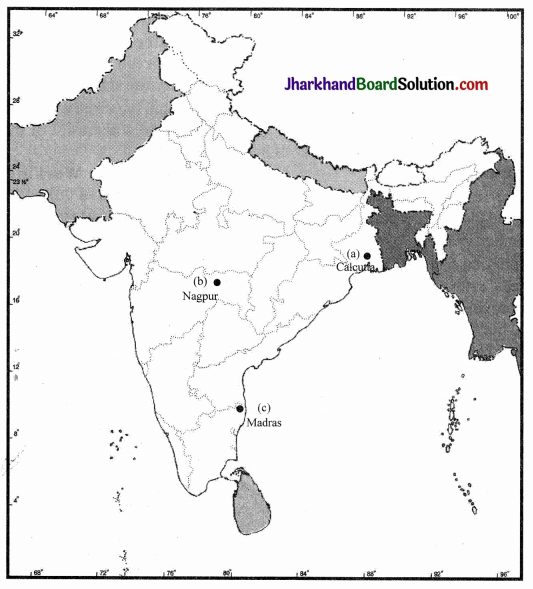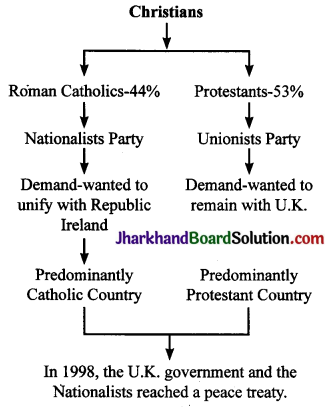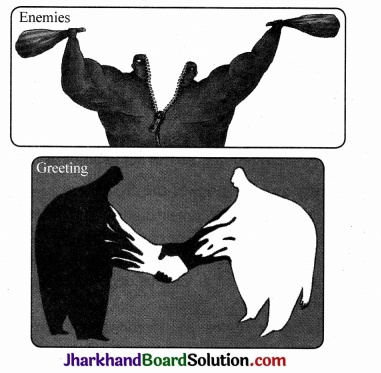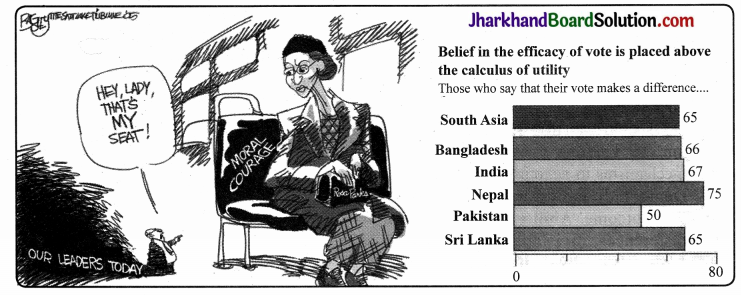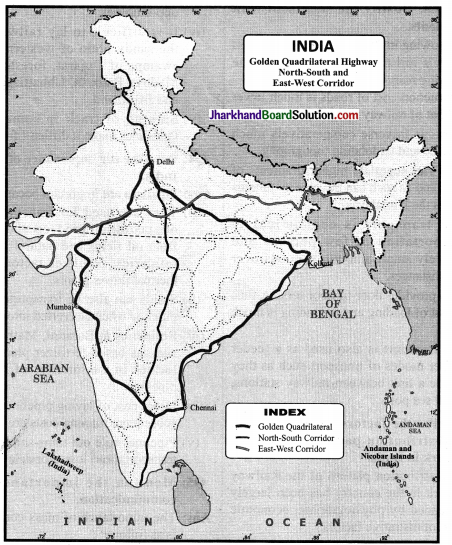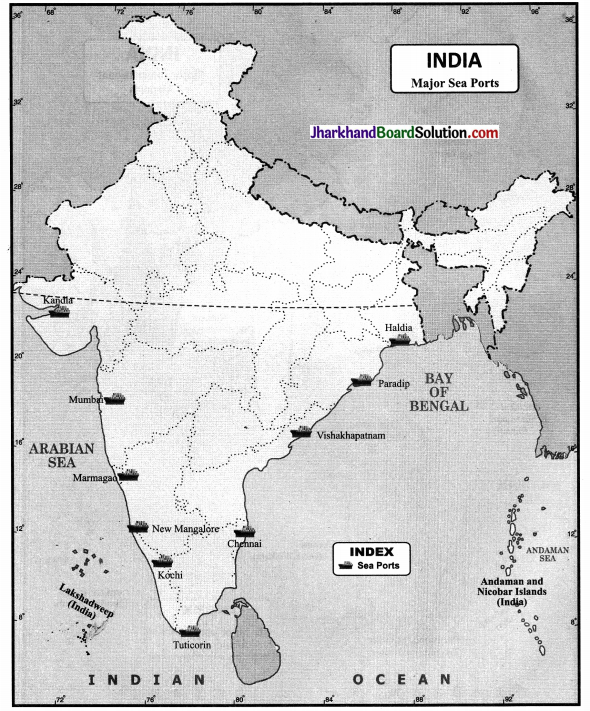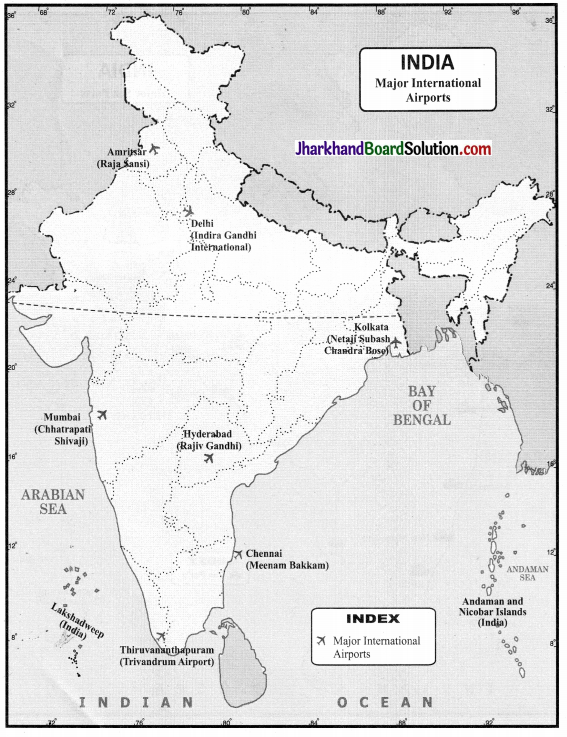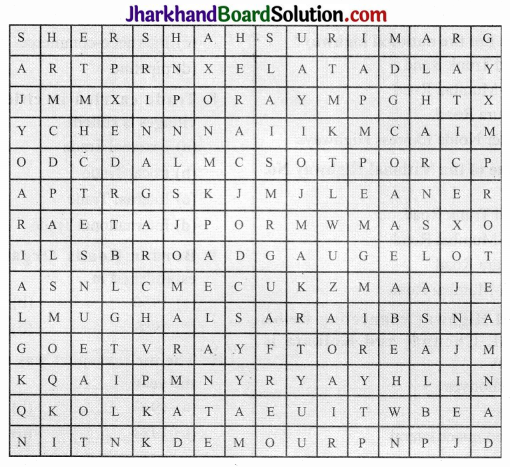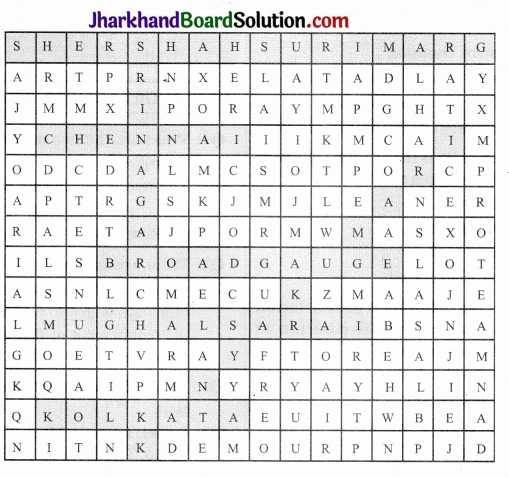JAC Board Class 10th Social Science Solutions Civics Chapter 1 Power Sharing
JAC Class 10th Civics Power Sharing InText Questions and Answers
Page 2
Question 1.
Look at the maps of Belgium and Sri Lanka. In which region, do you find concentration of different communities?
Communities and regions of Belgium
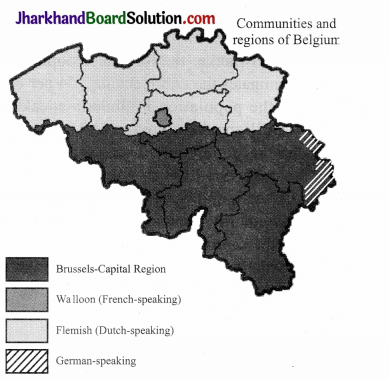
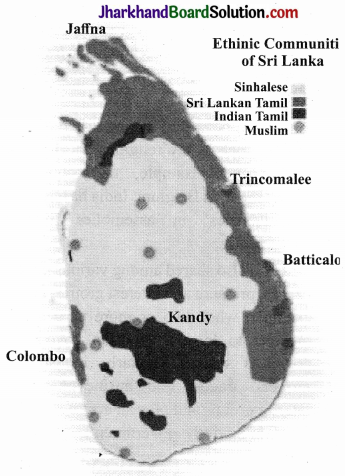
Answer:
In Belgium, there are two major linguistic groups: 59 per cent of the people live in the Flemish region (north) and are the Dutch-speaking people. Around 40% of the population occupy the Wallonia region and speak French. The one per cent German-speaking population lives in the eastern region of Belgium.
In Sri Lanka, the Sinhalese population dominates the entire country. 74 per cent of the population is Sinhala – speakers. Tamil speakers comprise 18 per cent of the population. There are two sub groups! Sri Lankan Tamils live in the northern and eastern coastal regions of the country. Indian Tamils are clustered in the central region and scattered in the southern region. Muslims are distributed throughout the country.
Page 5
Question 2.
Read any newspaper for one week and make clippings of news related to ongoing conflicts or wars. A group of live students could pool their clippings together and do the following:
- Classify these conflicts by their location (your state, India, outside India).
- Find out the cause of each of these conflicts. How many of these are related to power sharing disputes?
- Which of these conflicts could be resolved by working out power sharing arrangements?
Answer:
Hints:
Students can find out about conflicts from newspapers and also visit the newspaper archives. Within India, students may read about Cauvery Water Dispute between Karnataka and Tamil Nadu. Outside India, the students can study the American Civil War which was fought in the United States of America from 1861 to 1865 by President Abraham Lincoln against slavery.
![]()
Question 3.
Annette studies in a Dutch medium school in the northern region of Belgium. Many French-speaking students in her school want the medium of instruction to be French. Selvi studies in a school in the northern region of Sri Lanka. All the students in her school are Tamil speaking and they want the medium of instruction to be Tamil. If the parents of Annette and Selvi were to approach respective governments to realise the desire of the child who is more likely to succeed? And why?
Answer:
Annette’s parents are more likely to succeed when they approach the government because Belgian leaders recognised the existence of regional differences and cultural diversities. They have the community government, which is elected by the people belonging to one language, Dutch, French and German – speaking, no matter where they live.
This government has the power regarding cultural, educational and language-related issues. Selvi’s parents are less likely to succeed because the Sinhalese have established their supremacy in Sri Lanka. In 1956, an Act was passed to recognise Sinhala as the only official language, thus disregarding Tamil.
Question 4.
Can you help poor Vikram in answering Vetal?
(a) If you had the power to rewrite the rules in Lebanon what would you do?
(b) Would you adopt the ‘regular’ rules followed everywhere, as Khalil suggests? Or stick to the old rules? Or do something else?
Answer:
(a) Democracy is a government “of the people by the people and for the people”. But it doesn’t mean to make a situation that can cause disturbances and bloodsheds in the society. It is based on “live and let live”. So if there is an agreement among different communities in the country on the basis of fixed power sharing among them, it is right. There is no need to rewrite the rule.
(b) If the rules of the Lebanon is providing all the people to caste vote and contest elections as per agreement of power. sharing among different communities, I would not adopt the ‘regular’ rules followed everywhere, as Khalil suggests. I would stick to the rules made after agreement among different communities. I don’t need to do something else.
Question 5.
In 2005, some new laws were made in Russia giving more powers to its president. During the same time the US president visited Russia. What, according to this cartoon, is the relationship between democracy and concentration of power? Can you think of some other examples to illustrate the point being made here?
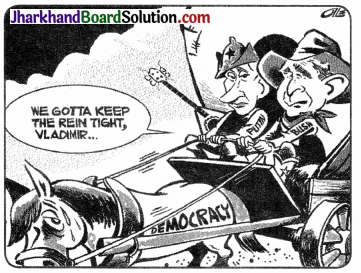
Answer:
(i) Democracy, in general represents the will of the common people. But when the power is concentrated in a particular hand, in a democratic government, this individual outlasts the will of the common people. The same thing has been shown in the cartoon where democracy is run by selected people, at their will, without taking care of the will of the general people.
(ii) We can illustrate a few more such examples. For example, in Pakistan, there is an elected democratic government but this is not the true representation of the will of the people. Once elected, the power – carrying men run the government as per their wishes. Iraq was another example where democracy was being run in an autocratic manner.
![]()
Question 6.
In my school, the class monitor changes every month. Is that what you call a power – sharing arrangement?
Answer:
No, the changing of class monitor every month cannot be called a power-sharing arrangement. Because, in power – sharing arrangement, there are different institutions and intersect groups which exercise their power and check the actions of each other. This arrangement is also called a system of checks and balances.
Page 10
Question 7.
Here are some examples of power – sharing. Which of the four types of power – sharing do these represent? Who is sharing power with whom?
(a) The Bombay High Court ordered the Maharashtra state government to immediately take action and improve living conditions for the 2,000 odd children at seven children’s homes in Mumbai.
(b) The government of Ontario state in Canada has agreed to a land claim settlement with the aboriginal community. The Minister responsible for Native Affairs announced that the government will work with aboriginal people in a spirit of mutual respect and cooperation.
(c) Russia’s two influential political parties, the Union of Right Forces and the Liberal Yabloko Movement, agreed to unite their organisations into a strong right – wing coalition. They propose to have a common list of candidates in the next parliamentary elections.
(d) The finance ministers of various stales in Nigeria got together and demanded that the federal government declare its sources of income. They also wanted to know the formula by which the revenue is distributed to various state governments.
Answer:
(a) (i) This is an example of power sharing among different organs of the government.
(ii) Here the power is shared between the judiciaiy and the executive.
(b) (i) This is an example of sharing of power among different social groups.
(ii) Here, the power is shared between the aboriginals and other social groups.
(c) (i) This is an example of power sharing arrangements in the way political parties pressure groups and movements control or influence power.
(ii) Here, the power is being shared between SPS and the liberal Yabloko movement.
(d) (i) This is an example of power sharing among governments at different levels.
(ii) Here, the power is being shared between federal and state governments and also among the state governments.
JAC Class 10th Civics Power Sharing Textbook Questions and Answers
Question 1.
What are the different forms of power sharing in modern democracies? Give an example of each of these.
Answer:
In modem democracies, power can be shared in many different forms.
(i) Horizontal distribution of power:
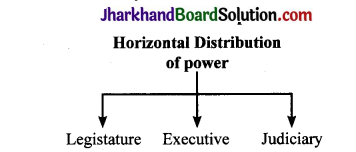
The different organs of the government at the same level, such as the legislature, the executive and the judiciary exercise different powers.
- This ensures that none of the organs can exercise unlimited power.
- Each organ checks the others. This results in a balance of power. For example, though the judges are appointed by the executive, they can check the functioning of the executive or laws made by the legislatures.
- This arrangement is called a system of checks and balances.
(ii) Vertical division of power:
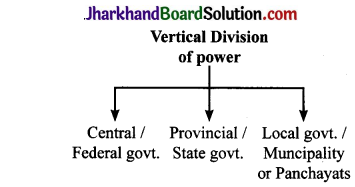
In this system, the power is divided among different levels of government, such as the central or the federal government, the provincial or state governments, and then the municipality and the panchayat. The constitution clearly lays down the powers of different levels of government.
(iii) Power is shared among different social groups, such as religious and linguistic groups/For example, the ‘community government’ of Belgium is elected by the people belonging to one language community, Dutch, French and German speaking, no matter where they live. This government has the power regarding cultural, educational and language – related issues. In some countries, there are constitutional and legal arrangements whereby socially weaker sections, and women are represented in the legislatures and administration.
(iv) Power is shared among various political parties, pressure groups and movements, which .control or influence those in power. Jn a democracy, the citizens have the right to choose among the various contenders for power. Two or more political parties share their power when a coalition government is formed. There are various interest groups, such as traders and businessmen, farmers, industrialists, etc. who have a share in governmental power, either through participation in governmental committees or bringing influence on the decision-making process.
![]()
Question 2.
State one prudential reason and one moral reason for power – sharing with an example from the Indian context.
OR
Give two reasons why power sharing is desirable.
Answer:
Power Sharing
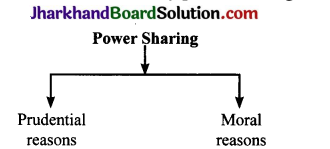
(i) Prudential reasons state that power – sharing will bring better outcomes. It helps reduce the possibility of conflict between social groups. It ensures the stability of political order. Imposing the will of the majority on others is not only oppressive for the minority, but also undermines the unity of the nation. For example, in India there are reserved constituencies in the parliament and assemblies for OBC, SCs and STs.
(ii) Moral reasons emphasise the very act of power – sharing as valuable. Power – sharing is the very spirit of democracy. A democratic rule involves sharing power with those affected by its exercise, and who have to live with its effects. A legitimate government is one where citizens, through participation, acquire a stake in the system.
Question 3.
After reading this chapter, three students drew different conclusions. Which of these do you agree with and why? Give your reasons in about 50 words. Thomman Power sharing is necessary only in societies which have religious, linguistic or ethnic divisions. Mathayi Power sharing is suitable only for big countries that have regional divisions. Ouseph Every society needs some form of power – sharing even if it is small or does not have social divisions.
Answer:
One will agree with Ouseph’s conclusion that every society needs some form of power – sharing even if it is small or does not have social divisions. Power – sharing is not affected or influenced by the size of the country. It is necessary in societies with linguistic, religious or ethnic divisions. This will make the population feel included in everything. It is also required in a country where there are no social or religious divisions for peace and stability of the nation.
![]()
Question 4.
The Mayor of Merchtem, a town near Brussels in Belgium, has defended a ban on speaking French in the town’s schools. He said that the ban would help all non – Dutch speakers integrate in this Flemish town. Do you think that this measure is in keeping with the spirit of Belgium’s power – sharing arrangements? Give your reasons in about 50 words.
Answer:
Defending the ban on speaking French in schools in Merchtem by the Mayor of the town is not in keeping with the spirit of Belgium’s power sharing arrangements. The Belgian model of governance accommodates and recognises the existence of regional differences and cultural diversities. They amended their constitution four times between 1970 and 1993 so as to work out an arrangement that would enable everyone to live together within the same country.
Question 5.
Read the following passage and pick out any one of the prudential reasons for power sharing offered in this. “We need to give more power to the panchayats to realise the dream of Mahatma Gandhi and the hopes of the makers of our Constitution. Panchayati Raj establishes true democracy. It restores power to the only place where power belongs in a democracy in the hands of the people.
Giving power to Panchayats is also a way to reduce corruption and increase administrative efficiency. When people participate in planning and implementation of developmental schemes, they would naturally exercise greater control over these schemes. This would eliminate the corrupt middlemen. Thus, Panchayati Raj will strengthen the foundations of our democracy.
Answer:
The prudential reasons are: Panchayati Raj establishes true democracy. In this system, true power lies in the hands of the people. It not only reduces corruption and increases administrative efficiency, but eliminates corruption of middlemen. People are directly involved in planning and implementation of developmental schemes. This keeps the people of all sections of the society involved in the functioning of the government. It brings political stability and reduces violence. It involves sharing of power.
![]()
Question 6.
Different arguments are usually put forth in favour of and against power sharing. Identify those which are in favour of power sharing and select the answer using the codes given below. Power sharing:
A. reduces conflict among different communities.
B. decreases the possibility of arbitrariness.
C. delays decision making process.
D. accommodates diversities.
E. increases instability and divisiveness.
F. promotes people’s participation in government.
G. undermines the unity of a country.
| (a) | A | B | D | F |
| (b) | A | C | E | F |
| (c) | A | B | D | G |
| (d) | B | C | D | G |
Answer:
(a) A,B,D and F
Question 7.
Consider the following statements about power sharing arrangements in Belgium and Sri Lanka.
A. In Belgium, the Dutch – speaking majority people tried to impose their domination on the minority French – speaking community.
B. In Sri Lanka, the policies of the government sought to ensure the dominance of the Sinhala -speaking majority.
C. The Tamils in Sri Lanka demanded a federal arrangement of power sharing to protect their culture, language and equality of opportunity in education and jobs.
D. The transformation of Belgium from unitary government to a federal one prevented a possible division of the country on linguistic lines. Which of the statements given above are correct?
(a) A, B, C and D
(b) A, B and D
(c) C and D
(d) B, C and D
Answer:
(d) B, C and D
![]()
Question 8.
Match List I (forms of power sharing) with List II (forms of government) and select the correct answer using the codes given below in the lists:
| List-I | List-II |
| 1. Power shared among different organs of the government | A. Community government |
| 2. Power shared among governments at different levels | B. Separation of powers |
| 3. Power shared by different social groups | C. Coalition government |
| 4. Power shared by two or more k political parties | D. Federal government |
Answer:
| 1 | 2 | 3 | 4 | |
| (a) | D | A | B | C |
| (b) | B | C | D | A |
| (c) | B | D | A | C |
| (d) | C | D | A | B |
Answer:
(c) B,D,A and C
Question 9.
Consider the following two statements on power sharing and select the answer using the codes given below:
A. Power sharing is good for democracy.
B. It helps to reduce the possibility of conflict between social groups. Which of these statements are true and false?
(a) A is true but B is false
(b) Both A and B are true
(c) Both A and B are false
(d) A is false but B is true
Answer:
(b) Both A and B are true
